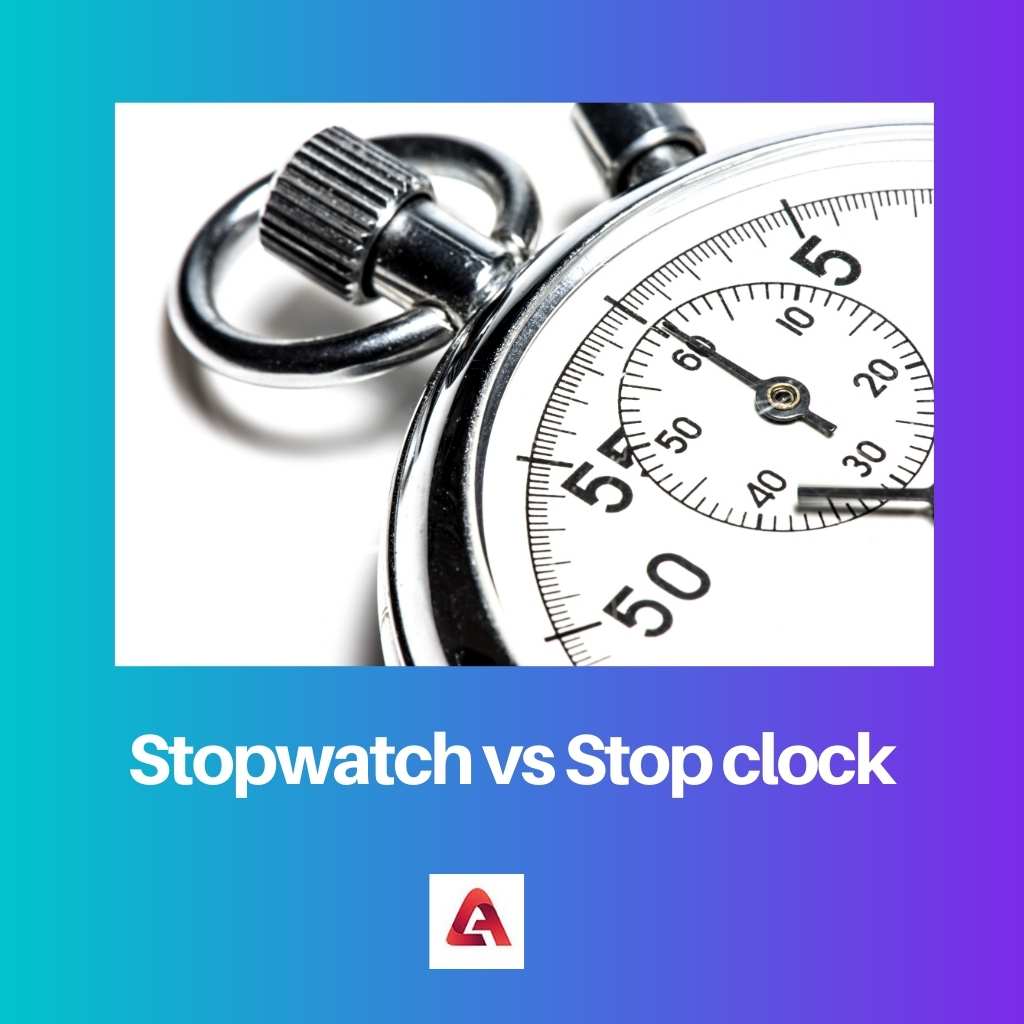Stopwatch and Stop clock both are designed to measure the amount of time that elapses between any two points of events. The timing functions of the stopwatch are controlled by two buttons which are the start and stop.
And there are also two scales in analog stopwatch called minute scale and second scale.
Key Takeaways
- A stopped clock is a type of clock that can be paused or stopped, used in laboratories or other settings where precise time measurement is necessary.
- Stopwatches are portable and commonly used in sports or other timed events, while stop clocks are larger and stationary.
- Both devices enable accurate time measurement, but stopwatches are designed for mobility and versatility, whereas stop clocks cater to specific settings and uses.
Stopwatch vs Stop clock
Stopwatches are handheld devices that are used for precise timing in sports, science experiments, and other applications, while stop clocks are larger clocks that are used for less precise timing, such as in classrooms, meetings, or other activities. Stopwatch is handy, whereas stop clock is bigger.

A stopwatch is a handheld timepiece that measures the amount of time elapsed from the time it is started to the time it is stopped. A mechanical stopwatch, similar to a pocket watch with an analog or digital face, is one type of stopwatch.
Digital stopwatches are more accurate.
A stopwatch is a clock that measures the amount of time that passes between the time it is activated and the time it is deactivated.
A stop clock is a huge digital version of a stopwatch meant for viewing from a distance, such as in a sports stadium.
Comparison Table
| Parameters of Comparison | Stopwatch | Stop Clock |
|---|---|---|
| Definition | A handheld timepiece measures the amount of time that has passed between the time it is triggered and the time it is deactivated. | A huge digital version of a stopwatch meant for viewing at a distance, such as in a sports stadium. |
| Least count | It has a better least count than a stop clock. | It is smaller in size as compared to a stopwatch |
| Size | It is smaller in size as compared to a stopwatch | It is larger as compared to stop the clock |
| Shifting of second-hand | After a particular number of ticks, the secondhand changes by one second. | After three ticks, the second-hand shifts by one division, or one second. |
| Least Count (seconds) | 0.2 or 0.1 seconds | 1/3 seconds |
What is Stopwatch?
A stopwatch is used to keep track of how long an event lasts. It’s a type of watch that stands out for its ability to accurately and precisely measure the time of an event.
It works by first pressing a start button and then pressing a stop button. It’s also called a chronometer, and it’s used to measure fractions of time that are short and precise.
Stopwatches can be divided into two categories: digital stopwatches and analog stopwatches. A stopwatch’s purpose is to accurately count the time of an event.
The timers are simple to use; simply press the start button to begin counting. When the event is finished, the timer on the stop button stops.
The time span covered by the recorded event, as well as other common data like time and date, will be displayed on the wristwatch’s face.
The stopwatch can be restarted to count another event or event. There are chronometer wristwatches, as well as models that can be worn around the neck or carried in the pocket.
A chronometer was invented for the first time in the early nineteenth century by a Swiss watchmaker named Louis Berthoud. He was able to perfect the string system.

What is a Stop Clock?
A stop-clock is a huge analog time-keeping device that measures the amount of time that has passed between the times it was started and stopped.
For example, if the stop clock started at 2:30:15 (hour: minute: second) and stopped at 2:32:20, 2min and 5 seconds had passed.
A stop-clock is just a bigger stopwatch that may be controlled manually or automatically (through sensors) and is used in sports stadiums to allow for better viewing from a distance.
A stopwatch’s index arm is analogous to an analog clock’s second hand. In one complete revolution. The best distinction is it has a least remember of 0.2s typically, while regular analog watches have a least remember of 1s.
which means the index arm ticks more than one time in a 2nd, like five instances for 1/5=0.2 least count. The cause of the index arm is to measure the wide variety of seconds elapsed.
The stop clock you select however will rely on your specific necessities. Digital stop clocks and stopwatches are glaringly extra correct and have buttons;
reset which resets the display to 0 and begin/prevent which with the first press starts evolved the timer and with the second one pauses it.
Main Differences Between Stopwatch and Stop clock
- The number of ticks per second and the amount of subdivision are adjusted in a stopwatch as the second hand shifts by one second after a certain number of ticks. In the case of stop clocks, however, the second hand shifted by one division, resulting in three ticks after one second.
- When sensitivity is taken into account, a stopwatch is more sensitive than a stop clock.
- A stopwatch has a higher sensitivity than a stop clock. The shortest count of a stopwatch is 0.5 seconds, and the shortest count of a stop clock is 1 second.
- The stopwatch has a minimum count of one-third of a second. The stopwatch, on the other hand, has a minimum count of 0.2 s or 0.1 s.
- Stopwatches provide accurate time readings for short periods of time, whereas stop clocks do not.

